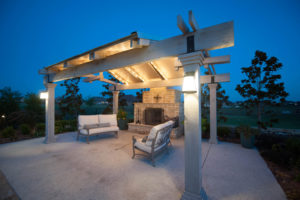62
Landscape Lighting

One area that is often overlooked by designers is backyard and pool area lighting. After dark and without proper lighting, homeowners may not be able to enjoy the beautiful landscaping and pool environment that they have spent thousands of dollars creating. In addition to the aesthetic benefits, safety (to avoid injury) and security (to avoid intrusion by a trespasser) are also benefits of lighting.
After determining what your motives are for your outdoor lighting, take a tour of your backyard and determine what you would like to illuminate. Then stand inside at the back of your house and determine what you would like to see when viewing the backyard and pool area at night. The next step is determining what type of lighting technique would best provide the desired look for the particular item that you are illuminating, followed by determining what type of fixtures would best serve your needs, and then selecting the proper method of controlling your lights.
Types of LightingUplighting
As the name implies, lights are aimed upward to illuminate. This is a particularly good method of illuminating trees.
Downlighting
This method works very well to create a light over outdoor activity areas, such as patios.
Spotlighting
This method tends to work well when trying to light waterfalls, statues, and occasionally plants or small trees.
Pathlighting
This is often done for safety as well as aesthetics.
Moonlighting—This is an increasingly popular method of lighting . It is most often done by mounting the lights in mature trees, with the fixture pointing downward. It tends to create the same shadowing effect as a full moon, creating a natural effect.
Types of Fixtures
Decorative fixtures—typically add to the landscaping during the day as décor.
Lanterns—This illumination is typically a soft light.
Path fixtures—This type of lighting creates lighting for pathways during the nighttime and decoration during the daytime.
Mounted or hanging fixtures—The main purpose of these types of fixtures is decoration, but they also provide some light benefit. The mounted variety are usually mounted n a post or an exterior wall. Hanging fixtures are less common, but are also used occasionally.
Functional fixtures—typically hidden from view and provide lighting benefits only.
Ground mounted fixtures—These are very common and are used to highlight structures, objects, or plants.
Surface mounted fixtures—Typically mounted on a building or tree to provide general lighting or accent lighting.
Ground-recessed fixtures—These lights are mounted below grade (flush with the ground) and typically used for highlight trees, statues, etc.
Types of Controls
There are several ways to operate backyard and pool area lighting. They are as follows—an on/off switch, a dimmer switch, a photoelectric control (turns on at dark), and time switches.
There are many resources for outdoor lighting information, including the following books:
The Landscape Lighting Book by Janet Lennox Moyer
The Art of Outdoor Lighting by Randall Whitehead
How to Design & Install Outdoor Lighting by William H.W. Wilson
There are many different considerations when planning and implementing backyard and pool area lighting, therefore it might be helpful to consult a landscape architect or lighting expert to help determine the best solution for your backyard and pool area lighting needs.
PLEASE NOTE: The recent trend of hanging string lights (also called Bistro Lights) over pools can be very dangerous. Most of these lights are not installed with safety in mind and you need to be aware that this type of lighting installation creates a very dangerous situation. If you are using these lights in this way, please consult a master electrician.




